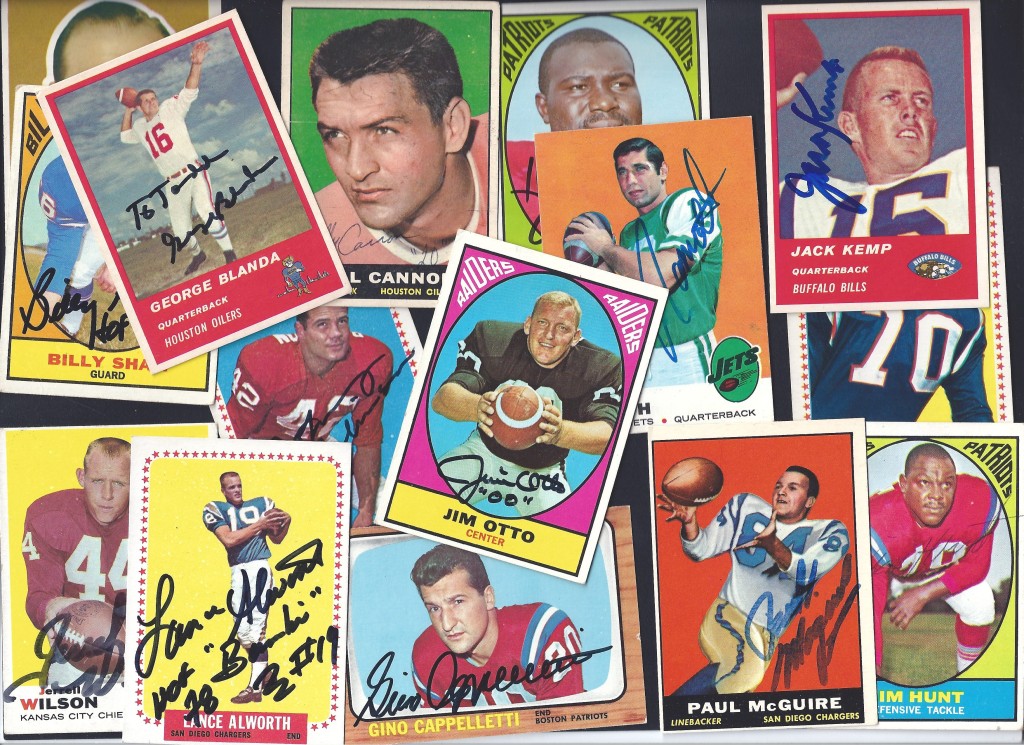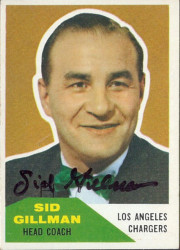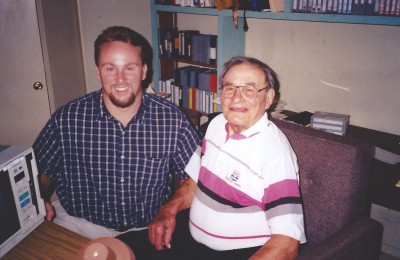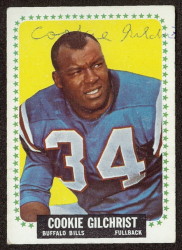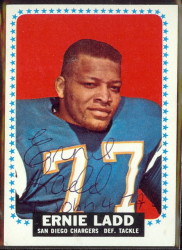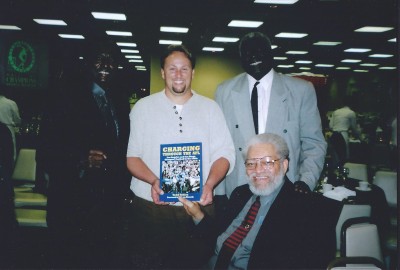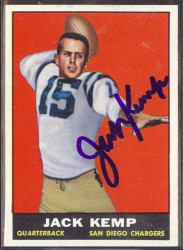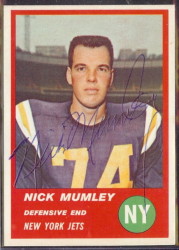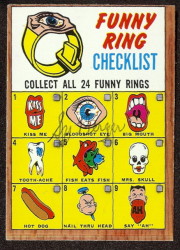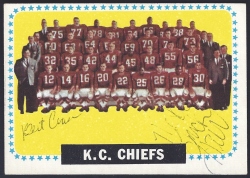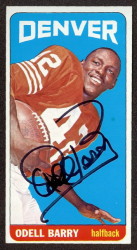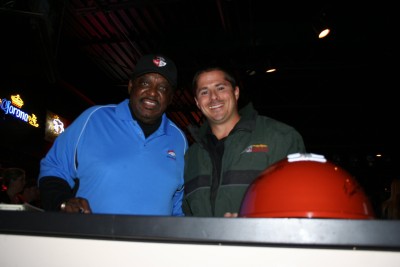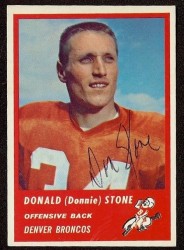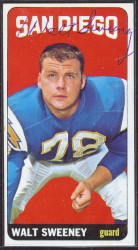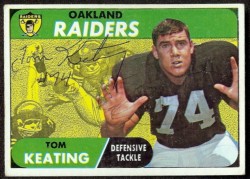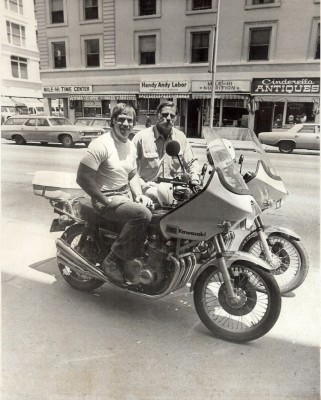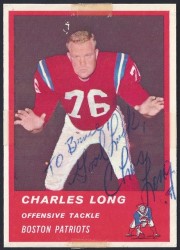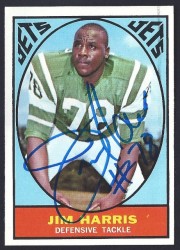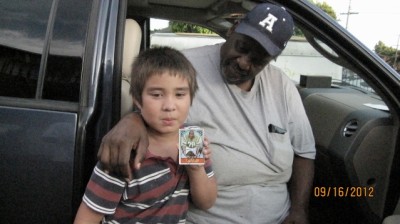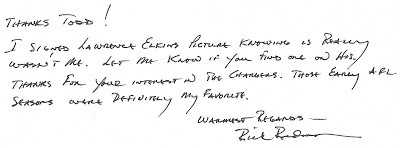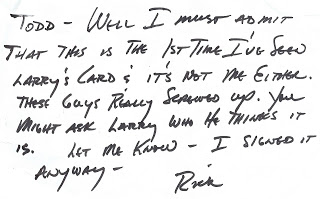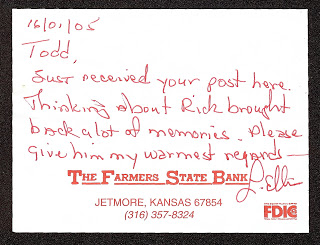I have always been a collector. You might say that I was born into it. As a child, my dad loved baseball, and collected cards with a passion. He grew up in Denver in the 1950s, and was a regular at Bears Stadium, where he collected game programs, photos, and autographs from the Bears players back when the club was the AAA-affiliate of the New York Yankees.
My father lost his card and memorabilia collection in the summer of 1969, when shortly after his college graduation, two children playing with matches accidently started a fire that consumed three homes and caused the death of his landlady. My dad never set about replacing that lost collection, but we spent many hours together during my childhood, talking about vintage cards and the collection that he was unable to pass down to his son.
Dad eventually moved on from baseball cards, and collected antiques of all sorts. As a result, I was raised going to every swap meet, garage sale, estate sale and antique store that we encountered. My dad would buy any number of things, some to keep and others to resell. While he went about looking for his own treasures, I followed in his footsteps, asking each vendor that I met, “Hey, ya got any baseball cards?”
I collected baseball cards and memorabilia from 1978 (when my dad bought my cousin and I a box each of 1978 Topps to keep us entertained on a motorhome trip from San Diego to Montana) through high school, college and beyond. Like my father, I quickly learned to buy-and-sell. In fact, I ended up quitting my after-school jobs in high school because I made better money buying childhood collections from my classmates and then wholesaling the cards to the many card shops around town.
In 1998, the focus of my collecting began to shift. I was in graduate school at the University of San Diego, and had selected the San Diego Chargers first head coach, Sid Gillman, as the subject of my master’s thesis. I was not very knowledgeable about football in the 1960s prior to beginning my research, but I had a collector’s mentality, so I picked up a few trading cards to get autographed when I was out interviewing old Chargers players.
I enjoyed the interviews greatly, and as I got to interview the likes of Sid Gillman, Earl Faison, Lance Alworth and Keith Lincoln, I soon developed an intense interest in the story of the AFL. And as is my personality, the more interested I became in the AFL Chargers, the more items I found to collect. I have always been of the “set collecting” mentality when it comes to sports cards, so my initial desire to pick up a few signed cards developed into a desire to collect all of the AFL Chargers cards in an autographed form. That initial collection blossomed into acquiring autographed Chargers team sets from 1960 through the current season, which I finally completed in 2012.
For my first several years collecting football, I stuck very strictly to the Chargers, and in particular, the 1960s Chargers. I was developing an appreciation of the entire AFL, but my expertise and connections surrounded the Chargers; I didn’t really have an entry point to the other teams.
A telephone call that I received in the summer of 2006, set a crack in that narrow perspective, and from that crack developed the collection of which I am so proud today.
I had made a bit of a name for myself as a local Chargers collector and historian. I had written two books on different periods in team history, and was occasionally quoted in the newspaper and on television about issues pertaining to the early Chargers. Once in a while, I would get a phone call from someone asking if I was interested in purchasing their Chargers memorabilia. These calls were mostly fruitless, with the “collections” consisting of recent stadium giveaways. This particular call, however, was decidedly more exciting.
Ken was a landscaper by trade, and a baseball card collector in San Diego. He was a personable guy, and got to talking with one of his older clients one day. Somehow the subject of baseball cards came up, and the older woman told Ken about the collection that she had in her garage. Her late husband had grown up in San Diego, and loved sports. He collected baseball and football cards as a boy, and often took them to Balboa Stadium and Westgate Park to get autographed. He had passed away in recent years, but she still had his childhood collection.
Ken ended up buying the entire collection. He only had interest in the baseball cards, so he found my phone number and called to see if I might want to purchase the football items. I drove over to his house and took a good look at everything. My initial thought was to perhaps cherry-pick the signed football cards of the Chargers that I needed for my collection. But when I looked at the scope of what laid before me, I quickly decided that it would be wiser to acquire the entire lot.
Ken had taken the baseball cards for himself, but what was left behind was a small archive of baseball and football in the San Diego in the 1960s. There were complete or near-complete football card sets from 1960-1964, including a beautiful 1963 Fleer set that had 40 of the 89 cards autographed in vintage blue ballpoint. There were magazines, game programs, photos and newspaper clippings. Lots of the stuff had been autographed; early 1960s Chargers programs with 10-20 signatures inside, PCL Padres scorecards signed by the team, press photos, newspaper photos and a child’s accumulation of his local sporting heroes. That the baseball cards were not included did not bother me in the least. It took me three trips to complete the deal, but I eventually gave Ken $2,500 and the bulk of my 1960s baseball cards in exchange for the entire lot.
I brought the collection home, and immediately began selling off pieces to recoup my investment. The baseball material went to Bill Corcoran, the non-sports cards sold via ebay, and I kept the football portion. That consisted of several Chargers game programs from the early 1960s, many of which contained great, vintage signatures. The jewel of the collection, at least in my opinion, was the autographed football cards. I mentioned the 1963 Fleer set already, but there were roughly 140 AFL cards, 1960-1965, all of which had been autographed in vintage blue ballpoint. I didn’t completely understand the quality of the collection at the time, but I did know that I now had several very desirable signed football cards.
While I immediately loved the cards, I was unsure how to proceed. Should I just keep the Chargers cards and sell the rest? Should I just keep a few favorites? Perhaps work on the remaining unsigned 1963s? Keep the whole lot?
Initially I decided that I would keep the entire lot of autographed cards. They were just too enjoyable to give up. But as I continued to look through the cards, I grew an increasing appreciation for those ’63 Fleers. I’d always loved that set, but aside from my Chargers, I’d never owned any. Now I not only owned a complete set, but nearly half of the cards were autographed. After much consideration, and input from friends in the collecting community, I decided to attempt to get the remaining 1963 Fleer cards signed.
I took the time to research the players on the unsigned cards, and determine who was still living. To those men I sent a package that included a nice letter, their card, and a self-addressed, stamped envelope. I also took things one step further and included a blue ballpoint pen in each autograph request. As nearly half of the set had been signed in blue ballpoint, I wanted to try and give the newer signatures a similar look to the vintage lot.
My goal was to get as many 1963 Fleer cards signed as possible, but when the opportunity arose, I stuck additional cards into my request packages. Each player was sent their ’63 Fleer, but if they had additional cards, I slipped them into the envelope as well. Unintentionally, this was the beginning of what became my autographed AFL set collection.
I told myself that I would just collect “extra” signed AFL cards. I figured that it would be impossible to complete the sets, but I could collect the cards for fun, and see how many I could obtain. I should have known better. As long as I have collected cards, I have been what you would call a “set collector.” I wanted to have complete sets of cards, and I worked towards that goal always. Collectors sometimes laugh about having OCD (Obsessive-Compulsive Disorder) when it comes to their collections, and I am the same way. I enjoy specific, focused collections more than large, rambling accumulations. I soon found that collecting completely-autographed AFL card sets struck a perfect balance with my own particular “Collector’s OCD.” With 20+ years in the hobby at that point, simply collecting the unsigned cards was too easy for me. I hadn’t been bitten by the graded card bug, and with the advent of ebay, all it took was money to complete card sets from the 1960s. Autographed cards, however, were a totally different animal. Building these sets required research and much letter-writing; it forced me to learn something new. I fell in love immediately. It was as though, after 30 years of purchasing sports cards and memorabilia, I had finally discovered what I was meant to collect.
I found great enjoyment in the process of building the sets. Locating checklists, researching dates of death, and writing letters was never a chore. In fact, it provided a certain joy. I guess that my “Collector’s OCD” finds comfort in conducting my research and tracking my collection so thoroughly.
I acquired a lot of nice AFL-related pieces over the next decade, but my autographed AFL card collection was the crown jewel of my sports memorabilia. The collection grew, and from it came forth the idea of Tales from the American Football League, my AFL blog and website. That site then helped me to locate several obscure players and get their cards signed.
Over the course of this collection I have met hundreds of people, enlisted the help of strangers and friends, been told tales and ultimately built what I believe could be the most complete autographed AFL card collection in existence. Today, as I put fingers to keyboard, I have collected 1,256 autographed cards out of a possible 1,278 in the collection. In my 35+ years of collecting cards and memorabilia, this is the collection of which I am the most proud, and from which I take the most enjoyment. Now I want to share with you some of the stories surrounding this collection – the Tales from the American Football League Card Collection, if you will. While the vast majority of the collection came via my diligence in writing letters and sending cards to former players, a smaller bit came from working with dealers and other collectors, and another portion was acquired in different and sometimes interesting ways.
The following stories are told in no particular order, but they are all in-fact true, enjoyable, and illustrative of the diligence, passion or insanity with which I built this collection.
SID GILLMAN – 1960 Fleer
The 1960 Fleer Sid Gillman is special not only because of my relationship with Gillman, but also because it was the first vintage football card that I was able to get signed back in 1998, when I was doing research for my master’s thesis.
I happened to be at a sports memorabilia store in Grossmont Center one day. It was one of those seasonal stores that crop up to take advantage of holiday shoppers. I was looking through a binder of older football cards when I stumbled upon the 1960 Fleer Sid Gillman. I’d never seen the card before, and was instantly struck by the card’s vintage appeal. The image is simply Gillman’s mug shot, but he is wearing a coat and a bow tie, a look for which he would become famous. I don’t recall the price, but it was less than $10, so I bought the card and went on my way.
I first met Sid and Esther Gillman through an introduction made by Bob Hood, a former ball boy of the Chargers back in the 1960s. Hood also happened to be on the Board of Directors at The San Diego Hall of Champions, and when he learned of my research project, offered to introduce me to Sir Sidney.
After work one day, I followed Bob up to the Gillman’s house in Carlsbad. We were able to sit down with Sid and his wife, Esther, and talk for a couple of hours about their time with the Chargers. It was the first on many such trips I would make, some on my own, and others with Kym Murray, my then-girlfriend who later became my wife.
At the end of that first meeting, I asked Sid if he would mind autographing a few items for me. He was always great with his fans, and said that he would be happy to sign. I pulled out a couple of old game programs and a photo or two, and my 1960 Fleer card. I’ve had a few signed copies of that card over the years. Some I’ve kept and others I’ve passed along. But that particular card that I got signed back in 1998 is still with me, and I hope always will be.
COOKIE GILCHRIST – 1963 Fleer, 1964, 1965, 1966, 1967 Topps
You never know where a simple note may take you. I happened to be reading an autograph collector’s online forum one day when I came across a simple thread in which a collector was asking about photos of the AFL legend, Cookie Gilchrist. I happened to have several, so I sent the collector a message about the photos in my collection.
The collector’s name was Chris Garbarino, and he went on to tell me about how he had come into contact with Gilchrist, a noted recluse who shunned autograph requests. He said that Gilchrist was having health problems, and that he was trying to raise some money through an autograph signing. All of the money would go directly to Gilchrist to help with his living expenses and medical care.
Chris said that he was looking for several different images of Gilchrist, and that if I could help him out, he could get something signed for me. That may not sound like much to the lay person, but Cookie Gilchrist was an incredibly difficult autograph to obtain. Through the years I had picked up most of his signed cards, but I still needed one for my 1964 Topps set. I agreed to help out, and sent several images of Gilchrist along with one of his 1964 Topps cards.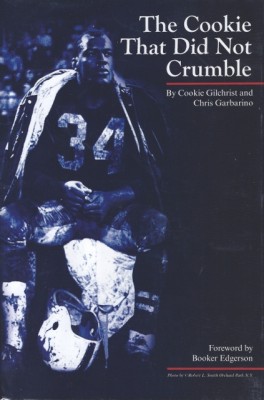
Little did I know at the time, but Chris Garbarino was a man with an incredibly big heart. He himself was an autograph collector, and he had quite unexpectedly, and very quickly, become a big part of Cookie Gilchrist’s life. Though they lived some eight hours away from each other, Garbarino visited with Gilchrist many times, and helped him wade through his medical challenges. Chris eventually got Cookie treated for cancer (which sadly took his life), moved into a new place, and gave some late-life dignity to the man who had been such a dominant presence when in health.
Chris got my card signed and sent it back to me. We kept in touch over the next several months while he helped Cookie, and later, when he was writing his incredible story which was eventually published under the title, “The Cookie That Did Not Crumble.”
Chris has since faded away from memorabilia collecting, but I will always be grateful to him for including me, even in such a tangential way, in his incredible story.
ALEX KROLL – 1963 Fleer
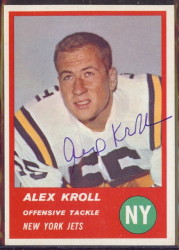 Alex Kroll played a single season in the American Football League. After a standout college career at Rutgers University, in which he captained the school’s first undefeated football team (1961) and made seven All-America teams as a center, Kroll was drafted by the New York Titans in the 1962 AFL Draft.
Alex Kroll played a single season in the American Football League. After a standout college career at Rutgers University, in which he captained the school’s first undefeated football team (1961) and made seven All-America teams as a center, Kroll was drafted by the New York Titans in the 1962 AFL Draft.
Kroll played for the Titans in 1962, but was frustrated with the unprofessionalism of Harry Wismer, and the shoestring budget with which he ran his football team. Kroll had worked as an advertising trainee in the offices of Young & Rubicam, so after completing his lone year in professional football, he retired and went to work fulltime for the advertising agency.
Alex Kroll rose swiftly through the ranks of Young & Rubicam, and was named CEO in 1985, a title he held for 10 years, before retiring in 1994.
Alex Kroll has multiple homes, one of which is in Vermont, in a town near where a collecting friend of mine happens to live. It is impossible to tackle a project like acquiring signed copies of all of the AFL cards without enlisting the help of friends. Fortunately, I’ve had many people help me along the way, and such was the case with Alex Kroll. I had tried to send cards to Kroll to sign through the mail, but had never had any success. So John Bennett, a collector of monumental proportion and a good pal, and I began discussing how we might get a signed copy of Kroll’s 1963 Fleer card into my collection.
It was a several-month long process, but by sheer chance, John Bennett, a high school history teacher, learned that the art teacher at his school happened to be Kroll’s daughter. He approached her one day after school to see if her dad might sign my card. She was quite nice about it, and took my card to her father. A week later I slipped my signed Alex Kroll card neatly into my binder , where it has been ever since.
ERNIE LADD – 1962, 1963 Fleer, 1964, 1965, 1967 Topps
Ernie Ladd was one of the biggest of AFL characters – literally and figuratively. At 6’9” and 325 lbs., there was no one larger. Additionally, the man had 500 lbs. of personality, which often aggravated his coach Sid Gillman, but endeared him to most everyone else.
I was able to interview Ernie Ladd in 2002. He’d had a long and interesting life by that point, and was totally candid in his stories about the 1960s Chargers. During that interview I learned that Ernie Ladd was battling cancer. I happened to also be working my way through an eight-month chemotherapy schedule, and we talked about our treatments.
After that initial interview, I made a point to call Ernie every few weeks to check in and see how his battle was going with cancer. We talked about chemotherapy and its side effects, his Chargers teammates and spirituality. I was working on my Chargers team set project at the time, and sent him cards and photos to autograph for my collection.
Ernie lived in Louisiana, and I figured that ours would simply be a telephone friendship. However in February 2005, roughly six months after Charging Through the AFL was published, Ernie Ladd was inducted into the Breitbard Hall of Fame at The San Diego Hall of Champions. I was not working for the museum at that point, but I had been invited by a friend to attend the Salute Dinner. I was not particularly excited about the dinner, but the opportunity to meet Ernie Ladd in person outweighed my misgivings.
That evening I brought along a copy of CHARGING to give to Ernie. We met shortly after the dinner had concluded. Dick Westmoreland and Earl Faison were there as well, and we all had a great conversation. I was able to give the book to Ernie, who was most pleased with the gift. My friend, Bill Swank, happened to be there with his ubiquitous camera, and he snapped a photo to commemorate the occasion.
Ernie Ladd died just two years later. The cancer that had previously been in remission, came back with a vengeance. Our phone conversations had dwindled, and I never got to meet Ernie again. But for that short period, I enjoyed my connection with the Giant Cat.
JACK KEMP – 1960, 1961, 1962, 1963 Fleer, 1961, 1964, 1965, 1966, 1967, 1968 Topps
Jack Kemp was not a particularly easy through-the-mail (TTM) signature. With his political offices, charities and countless obligations, I suspect he simply didn’t have time to fulfill autograph requests. By all accounts he was a nice person, and one who appreciated his fans, but there are only so many hours in the day.
Unfortunately for me, Kemp was a very popular player in the old AFL, and as such had at least one card in most every set. Ten cards total! The other problem was that his cards were not cheap, and to simply send them off blindly and hope for their return was not a gamble that I was willing to take.
I had written a book about the 1960s Chargers, and found that they were rather popular with the players. The book contained interviews, stats and nearly 400 old photos; plenty to jog the memories and old stories of even the most forgetful of former athletes. I hadn’t been able to get to Kemp for an interview for my book, so I was reasonably sure that he had never seen it. On that hunch, I sent him a copy in the mail, along with a letter asking if he would mind signing my cards.
Roughly ten days after sending the book, I went out to the mailbox and found a response from Jack Kemp. I ran back in the house, opened the envelope, and found a note from Kemp thanking me for the book, and agreeing to sign my cards. I was simply ecstatic. I went into my office and wrote a letter for what would ultimately be the first of two batches of cards and photos that Jack Kemp signed for me.
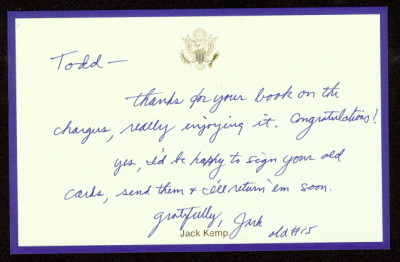
NICK MUMLEY – 1963 Fleer
Nick Mumley has a 1963 Fleer card, and was one of the first AFL signatures that I sought out back when I began working on my ’63 set. He was a prompt and courteous signer, and I had my card back within two weeks. As I was scanning the card for my digital catalog, I noticed that on the back of the card, Mumley had crossed out the listed hometown of Lafayette, Indiana, and neatly written in “Wheeling, WV.”
My grandparents, John & Dorothy (Marshall) Lenore had both grown up in Wheeling, which then as now, was a very small town. I wondered what the chances are that they knew each other?
I called my grandmother and asked her is she’d ever heard the name, Nick Mumley. “Oh yes,” she said. “He was a great athlete back on the island (Wheeling). “ She remembered him from when she was young, and in fact, he was still good friends with my great-aunt’s husband, Fritz.
I managed to track down a phone number for Nick Mumley, and gave him a call. I thanked him for signing my card, and then relayed the story about my family and Wheeling. I couldn’t believe it, but he remembered my grandmother as well. We spoke for several minutes, and he told a few stories about the New York Titans. I later wrote him a note and asked him to sign a 1962 Fleer card for me. He signed the card and sent back a note saying that he had since seen my grandmother at a wedding in Kentucky, and how neat it was to make these connections.
SY BERGER – 1966 Topps Funny Ring Checklist
In amongst the 1,278 cards associated with my AFL collection, there is one card that truthfully does not belong in a football set. In 1966, along with trading cards and a stick of bubble gum, Topps included cardboard “Funny Rings.” These perforated rings came in a card-sized piece of cardboard, and had such ridiculous themes as “Nail Thru Head,” “Bloodshot Eye,” and “Hot Dog.” Kids either played with the rings or tossed them away. The problem, at least for collectors, is that card #15 in the 1966 Topps set is the infamous Funny Ring Checklist. As silly as it was, a ’66 Topps set is not complete without card #15.
It is one thing to add this card to your set, but when you are an autographed set collector, who do you get to sign that card? Normally I would reserve checklists for certain players, or league officials. The problem was that not only were most of the league officials deceased, but it made absolutely no sense to have their signatures on this goofy card.
I polled several of my friends, and they all told me to leave the card unsigned. In fact, why even buy one? But that just didn’t feel right to me. I couldn’t go along saying that my set was complete, “except for the stupid Funny Ring Checklist.”
I was bemoaning the situation to fellow collector, John Bennett, when he threw out the name of Sy Berger. Immediately, that made sense. Berger was a longtime executive for Topps, and considered the father of modern baseball cards. He had absolutely nothing to do with the AFL, but he had everything to do with the 1966 Topps set. He was the perfect person to sign that card.
I called my friend, Jim Steeg, a former vice president with the NFL, a collector, and friend of Sy Berger. Jim said that he would be happy to get Sy to sign the card for me, so I dropped it off with Jim, and came back two weeks later to pick it back up.
Jim laughed and said that Sy really wasn’t sure why anyone would want him to sign that card, but he was happy to do it. That card, likely the only Sy Berger-autographed Funny Ring Checklist in the entire world, sits neatly in my binder, between cards #14 (Jim Whalen) and #16 (Stew Barber), totally out of place, and yet exactly in the right spot.
MACK LEE HILL – 1964 Topps Kansas City Chiefs team card
I have written various articles about the most difficult-to-find autographed AFL cards of the 1960s. The 1964 Dick Christy and 1968 Frank Buncom are exceptionally challenging due to the fact that both players died shortly after those cards were issued. However, I was able to obtain another signed AFL card that has an equal or even greater degree of rarity. In fact, prior to seeing it for sale on an eBay auction, I had never even thought it might exist.
In their 1964 football set, Topps issued team cards for each of the AFL franchises. For my signed set I acquired team cards signed by each of the head coaches that season. I also enjoy picking up additional team cards of favorite players or AFL personalities. Included in my collection are team cards signed by Lance Alworth, Ernie Ladd, Sid Gillman, Al Davis, Hank Stram, Ben Davidson, Sammy Baugh, Cookie Gilchrist, Ralph Wilson and others. This other acquisition, which cost me $176.00, quickly became the rarest in my collection; it is card #110 in the 1964 Topps set, a Kansas City Chiefs team card that was autographed by Mack Lee Hill.
Mack Lee Hill was a free agent rookie running back with the Chiefs in 1964. He made the team and ended up as Kansas City’s second-leading rusher that year with 567 yards and four touchdowns. Hill was wrapping up a second successful season in 1965, when he ruptured a knee ligament in a December game against the Buffalo Bills. His season over, Hill entered Menorah Medical Center on December 14, 1965, to have to knee surgically repaired. Shortly after the surgery was concluded, Hill went into convulsions and died in the operating room. The cause of death was a massive embolism. Hill was the second Chiefs running back to die while on the active roster, following Stone Johnson who died after suffering a broken neck in a 1963 exhibition game. In 1966 the Chiefs honored Hill by implementing the Mack Lee Hill Award, which is given annually to the Chiefs rookie of the year. Mike Garrett, Christian Okoye and Derrick Thomas are just a few winners of the Mack Lee Hill Award.
As is to be expected, there is very little Hill memorabilia available. He never had a regular issue card, and is featured solely on a Chiefs team issue. This particular card bears two signatures, Bert Coan and Hill. Coan, a Chargers and Chiefs back who spent seven seasons in the AFL, signed boldly on the left of the card. The Hill signature is a bit fainter, and includes Hill’s nickname, “Truck.” Assuming that Topps cards were available to the public by August of 1964, Hill would have had just 17 months in which he could have signed these cards prior to his death in December the following year. Additionally, with the fact that this is a team card and Hill is not featured on a card of his own, I have to believe that this is one of the few, if not the only, Mack Lee Hill-autographed Topps card in existence.
ODELL BARRY – 1965 Topps
I have tried to get Odell Barry to sign his card through the mail, but have been unsuccessful in two attempts. So I figured that I needed to find another way. I did a bit of research, and learned that Barry is an active board member of the Denver Broncos Alumni Organization. The group happens to have a active Facebook page, so I joined in October 2010. The group sends out Facebook posts about upcoming events, and I saw that they had an alumni rally upcoming for Broncos appearance in a Monday Night Football game against the Chargers. The event was happening at a brew pub in Denver, and I was able to send the administrator of the Facebook page a couple of messages and confirm that Barry would be in attendance.
With Barry’s attendance confirmed, step two of my plan was to drop a line to Matt Thompson, one of my old college lacrosse friends, who is a Denver native and returned to the area after college. I told him about the rally and how I wanted to get the card signed for my collection. Matt said that he would be happy to get it done for me, so I dropped the card in the mail with some money to cover a few beers for himself and Odell. I also added a checklist of the 1965 Topps set, along with notations for which cards I already had autographed, and info and dates for the players that are deceased. I have found that many of the old players really appreciate this information because they lose track of so many of their teammates and former opponents.
About an hour into the MNF game, Matt called me to say that Odell Barry had happily signed the card. Matt showed him the 1965 Topps list, and Barry was apparently very interested. He actually asked if he could keep the list, which was more than fine with me. So Matt bought him a beer and they shot the breeze for a while, and had a good time.
I went out to the mailbox on November 26, 2010, and found my card in the SASE that I had sent to Matt. Another funny thing was that when I went back to Facebook to look at the photos taken at the MNF event, I found one of Matt and Odell talking together.
DONNIE STONE – 1963 Fleer, 1964 Topps
I began collecting my signed 1963 Fleer set back in 2007. I purchased my set of 88 cards with about 45 of them already signed in vintage blue ballpoint. So to finish the set, I sent blue ballpoint pens to all of the guys when I sent them their cards. Pretty much everyone that I wrote to happily signed their card with the enclosed pens and sent them back to me – all but Donnie Stone. So I waited about six months and sent him another 63 Fleer card and pen – again, no luck.
I mentioned this one day to Lance Alworth, who was a college teammate of Stone. Lance told me that Stone was a great guy, and to call him and say that Lance prompted my call. He was sure that Stone would sign then. So I followed the advice, called Stone and we spoke for about 30 minutes. He was very cordial. We talked about college ball and the AFL. He said that he thought highly of Alworth, and that he thought he could help me get my Jack Kemp card signed. He said that he usually didn’t sign, but that he would for me and to send the cards. By this time I had expanded into collecting all of the AFL sets in autographed form, so I sent Stone his two cards – 63 Fleer and 1964 Topps. Nine months went by with no luck. I sent him a friendly reminder note, but still got nothing in return.
Then two years ago I tried again. I had acquired a couple of very nice, vintage 8×10 action shots of Stone running against the Chargers. I had two of each print, so I figured that I would try to send him the prints as a gift and see if that gesture might get my cards signed. I sent him a Priority Mail envelope with a letter that again kindly reminded him that I never got back the cards after our phone conversation, the two prints, an excel printout of my 63 & 64 sets, with highlights to show his cards, a ballpoint pen and each of his cards. Again, nothing.
In March 2011, I decided to make one final attempt at the elusive Donnie Stone. Again I wrote a nice note, included the excel printouts, 63 Fleer and 64 Topps cards and a blue ballpoint. The only difference this time was that I also included a $20. I figured my package was a goner again after a month went by with no return. But lo and behold, I went out to the mailbox on July 20, and found my return envelope postmarked from Oklahoma. I hadn’t been sending out many cards lately, so I was cautiously optimistic about the cards inside the envelope. I grabbed a knife, slit open the top, and slid out two beautifully-signed Donnie Stone cards – 1963 Fleer and 1964 Topps.
Most people won’t remember Donnie Stone, and his signature will likely mean little to the majority of football fans. But to me they represent a four-year hunt, and a very enjoyable through-the-mail success.
WALT SWEENEY – 1965 & 1966 Topps
Walter Francis Sweeney… The guy was a tremendous ballplayer, and deserving of a spot in Canton. First round draft choice of the San Diego Chargers, second player overall in the 1963 AFL Draft… Earned his starting position in 1964, and played in 181 of 182 games during his career… Named to nine AFL All-Star/Pro Bowl games… Named All-AFL/All-AFC five times…
I first met Walt at his home in King’s Beach at Lake Tahoe back in 1998, when I was doing research for my master’s thesis on Sid Gillman. Walt and I stayed in contact over the years. I met with him again a couple of times in the Tahoe area, and many more times when he and his wife, Nanci, moved back to San Diego. Walt signed many cards and photos for me, and was always a nice guy to be around.
I learned of Walt’s cancer one weekend in January 2013. Tom Miller and I had an opportunity to go visit him on Friday, February 1. Walt was in good spirits. He was understandably weak, but was happy to have company, and chat. We were there for two hours, and during that time his daughter came by, as did an old high school friend of Walt’s that had scheduled a layover in San Diego on his way from Hawaii back to Boston.
We all sat and talked about different periods of Walt’s life. There was a fair amount of laughter, and gratefully, no tears. When we got up to leave, I shook Walt’s hand, and said that I would call him to visit again the following week. He said that he would like that. Little did I know (though maybe Walt suspected), that this would be his last full day on earth.
Walt died the following day (February 2, 1013) after a short battle with pancreatic cancer. He had been diagnosed just two weeks prior, and the doctors had given him about 4-6 weeks to live.
I feel like Walt never really knew peace in his life. He had a tough home life when he was young. His father died when Walt was just two years old. From there it was growing up with a lot of siblings and not a lot of money. Alcohol was a big influence on Walt’s life from early on. Once he got into professional football, harder drugs became a regular escape for him. He spent the next 50+ years trying to kick his addictions, mostly unsuccessfully.
I hate to see my AFL guys passing away, and it becomes tougher when they happen to be friends. I hope that Walt now has the peace that eluded him during life. He made many mistakes, and often repeated them, but I believe that he was a good man on the inside. Rest well, Walt. I will miss you.
TOM KEATING – 1965 & 1968 Topps
Raiders defensive linemen Ben Davidson and Tom Keating both feature prominently in these AFL collections of mine, and while I had been able to get all of my Davidson cards signed at one point or another, I hadn’t had nearly the same success with Keating. Fortunately for me, Ben Davidson happened to live about two miles from my home, and despite his on-field image, was one of the nicest people that you could ever hope to meet.
Ben and I had interacted several times over the years, and I had been to his home in La Mesa. So stuck with my unsigned Tom Keating cards (as well as other Raiders, J.R. Williamson and Isaac Lassiter, at that time), I gave Ben a call to see if he happened to still be in touch with any of these guys, and if he might have some tips for me on how I could get my cards signed. As luck would have it, Davidson was still in contact with Keating, and as a matter of fact, Keating was coming to stay with him for a few days the very next weekend. Ben invited me to come over to the house, where I could meet Keating and have him sign my cards.
So on a cool Saturday afternoon in October 2009, I made my way up to the Ben Davidson’s home. I was armed not only with the cards that I hoped to get signed, but also the two binders that house my collection of signed AFL cards. I also brought along a nice bottle of merlot as a “thank you” for Keating, as Ben had mentioned that Tom enjoyed red wine.
After ringing the doorbell, Ben welcomed me in, and took me to the kitchen table where Keating was sitting. Introductions were made, pleasantries were exchanged, and Keating happily signed my cards. As Ben passed around cups of coffee and joined us at the table, I brought out my binders and the old Raiders linemates began flipping through the pages. What began as a quick trip to get a couple of signatures on some bubble gum cards turned into two-and-a-half hours of laughter and stories, that came flooding back each time a page of cards was turned and long-forgotten teammates and opponents were recalled to memory…
- Dan Birdwell, who couldn’t shave without cutting himself a dozen times, and whose ear lobes somehow stuck out from the bottom of his football helmet.
- John Bramlett, who Keating recalled as “the dirtiest sonofabitch I ever played against,” but who later ran a large and successful Christian ministry.
- Billy Cannon, later a dentist, who ironically is pictured in his 1967 Topps card with a gap in his mouth because his bridge wasn’t in.
After the binders had been put away, Ben and Tom began telling stories of their off-season excursions. These two teammates shared an appetite for adventure, and once the football season ended each year, they would hop on their motorcycles and go riding for months at a time. All over the country and through Mexico, beginning with no real destination in-mind and just seeing where their bikes would take them. It seemed a fitting off-season plan for a couple of guys who reveled in the Raiders bad boy images for the other seven months of the year.
Two years after meeting with Ben and Tom, purchased a photo of the two teammates on eBay. It arrived a few days later, and turned out to be even more enjoyable than the auction listing had made it appear. The photo was apparently taken by a Denver Post photographer on June 8, 1976, and used in the newspaper soon after. It featured the two on their motorcycles, and the caption, clipped from the paper and affixed to the back, read “Tom Keating and Ben Davidson, traveling the highways in search of a song.”
Since receiving the photo, I made copies to give to Ben and Tom. It is the least that I can do. As a football historian and fan of the old AFL, sitting with them that day, sipping coffee and listening to their stories was like a dream come true. It was simply one of the greatest collecting experiences of my life.
CHARLES LONG – 1963 Fleer
The 1963 Fleer set was my introduction to autographed set collecting, and as such, has a certain degree of importance to me. I have appreciated the set for as long as I can remember. In fact, I recall wanting to collect the set when I was in high school, but knowing that I really couldn’t afford it. Even after I began my professional life I would look at the prices of 196 Fleer cards and wonder if I would ever be able to build a set. That lent all the more importance to finding that large lot of signed 1963s back in 2006.
I worked hard to build this signed set. I researched addressed, sent out more than 25 letters, hunted, found and traded for or purchased signed examples of long-deceased players… This was not an easy task.
Eventually I got to the point where I had all but one card signed. I reached 88-of-89 cards in this set, and stood there for more than two years. The card that I needed to complete my set was #6 in the set, Boston Patriots lineman, Charles Long.
It made sense that Long was the last card that I needed. Along with Bob Dougherty and the unnumbered checklist, Long was one-of-three short-printed cards in the 1963 set. I had been fortunate to get the Dougherty card in the large lot. I later purchased a checklist and got it signed by Lance Alworth, who was named AFL Most Valuable Player in 1963, and whose Chargers’ won the league title that season. Additionally, Long had died in 1989, so ultimately I was searching for a short-printed card autographed by a lineman who had died nearly 25 years ago. Not a simple task.
I was sitting in the Bugsy’s Brew Coffee Shop one morning in September of 2013. I had a meeting later in the morning, so was killing some time with a cup of coffee and some relaxed eBay searches. I had always scanned eBay for my signed cards by running a search for “196*” in the autographed football card section. Running the search in that fashion pulled up all of the 1960s cards from that section. It had worked well for me for many years, and I had not ventured from it.
On this sunny morning, however, I had run through all of my standard searches, and still had time. So I set about running the names of each player whose signed card I needed. Running a search in this fashion would bring up anything in which the player was listed – unsigned cards, game programs, photos, signed index cards and the like. I had to weed through a lot of non-applicable stuff, but it helped fill the time.
Charles Long had a few bubble gum cards, but for some reason, he was listed as “Charlie” on some, and “Charles” on others. So I ran a search for “Charles Long,” his name on the Fleer card, and began scrolling through the listings. I got somewhere down the line when I noticed a 1963 Long card with some writing on the front. I took a closer look, and could barely believe my eyes. I was looking at an autographed 1963 Fleer Charles Long card with a Buy It Now price of $35. I hit the button, ended the auction, and sent a PayPal payment before I could think twice about it. Then I took a closer look.
Looking over his other listings, the seller had a large collection of signed 1960s & 1970s football cards. However, he had mistakenly listed them in the eBay section for football cards, not for autographed football cards. As a result, the card had never come up on my previous searches. The card that I had purchased was inscribed, “To Bruce,” as were others scattered through the listings. I figured that I would upgrade if I ever found another without personalization, but as time passes, that seems less of an issue.
On this otherwise non-descript September day, I had completed a project that I had started some seven years earlier. It was not only a project, but a wholesale change in my collecting focus, and something that eventually spawned Tales from the American Football League, and got my name out as a knowledgeable AFL historian and collector. Truthfully, it was a rather numbing experience that was only made concrete when the card arrived in the mail a few days later.
I have since completed several more sets and worked on many projects, but finishing my autographed 1963 Fleer set remains my greatest collecting achievement to date, and perhaps always.
FRANK BUNCOM – 1969 Topps
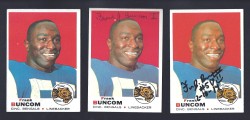 The 1969 Topps Frank Buncom card is the only regular issue AFL card that cannot be found in an autographed form. Through a bit of sleuthing, I learned that the second series of the 1969 Topps football set was issued to the public roughly two weeks after Frank Buncom’s unexpected passing on September 21, 1969. For several years, I simply kept an unsigned copy of the card in my set.
The 1969 Topps Frank Buncom card is the only regular issue AFL card that cannot be found in an autographed form. Through a bit of sleuthing, I learned that the second series of the 1969 Topps football set was issued to the public roughly two weeks after Frank Buncom’s unexpected passing on September 21, 1969. For several years, I simply kept an unsigned copy of the card in my set.
I was scanning through Facebook one morning in April 2011, when I read a post by one of my old high school football coaches. I noticed that a young man named Frank Buncom IV had replied to my coach. I shot the kid a message, and it turned out that he was the grandson of former Chargers linebacker, Frank Buncom.
I asked Frank IV if he would like to see some photos of his grandfather during his playing days. He said that he would, so I scanned a bunch of photos that I have, and posted about Buncom on Tales from the American Football League. Frank IV was pleased to see them, so I mailed him a disc from which he could make prints for himself and family.
Several months later, Steve Smith of Channel 10 News contacted me. I would occasionally do historic football stuff on camera for Steve’s broadcasts. He had heard about Frank IV, who had become a highly-touted high school football player. Steve wanted to know if I could put together some Frank Buncom material, and show it to Frank IV for a news spot. I put a binder together, and we met Frank IV at a St. Augustine’s football practice. He was a very well-mannered young man, and I enjoyed meeting him very much.
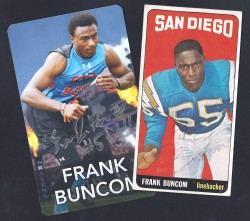 We kept in contact via Facebook after that. When I sold the bulk of my memorabilia in the summer of 2014, I sent Frank IV a photo and index card that had been autographed by his grandfather. As a thank you, he autographed a card for me that he had been given at a high school football combine.
We kept in contact via Facebook after that. When I sold the bulk of my memorabilia in the summer of 2014, I sent Frank IV a photo and index card that had been autographed by his grandfather. As a thank you, he autographed a card for me that he had been given at a high school football combine.
We have continued to keep in touch, and from a distance I have watched Frank develop into an incredible young man and fantastic football player (he will be attending Stanford and playing football as a freshman in 2015). In fact, when my son recently expressed an interest in attending the same high school as Frank, I reached out to and asked Frank a bit about the school. Rather than sending a long reply, he offered to tour my son around campus, so Toby and my wife, Kym, spent an afternoon with Frank and his friend, learning about and touring St. Augustine High School.
I am not sure why the idea took so long to come to me, but I eventually thought it would be nice to have Frank IV sign his grandfather’s 1969 Topps card for my set. I had become Facebook “friends” with his father as well, Frank III, who had been just three weeks old when his father passed away in 1969. I sent a copy of the card for each to sign. Now I keep three copies of the 1969 Frank Buncom card in my set – an unsigned copy, one signed by Frank Buncom III, and another signed by Frank Buncom IV.
JIM HARRIS – 1967 Topps
In August 2012, I posted a story on Tales from the American Football League about Jim Harris’s career with the New York Jets, and also how I had hoped to interview him for this blog. As well, Jim Harris was the last living member of the 1967 Topps football card set that I hoped to sign a card for me, and I had not been able to locate him.
Fast forward to September 9th, when I received a comment on that blog post from a reader named, “J.P.” J.P. said that he had actually met Harris a few months back. He went on to say that Harris lived near his girlfriend and her son, that he was a really nice guy, and that J.P. would be happy to try to get my card signed for me. Needless to say, I was thrilled for the opportunity. J.P. and I began trading emails, and it was determined that he would ask Harris to sign five copies of his card. One would be for his girlfriend’s son, and I would get the other four. He also mentioned that Harris loved Omaha Steaks, and so I sent along a gift card as a “thank you” for his time and signatures.
Four or five days went by, and I received an email back from J.P. He had attached a wonderful photo of his girlfriend’s son, Nick, with Jim Harris. The young boy was holding a signed Harris card, while sitting on Harris’s lap. The note said that my cards had been signed, and were on their way back to me. Two days later, my postman delivered the package, and with that, my autographed 1967 Topps set was complete. This was the first autographed set that I had ever completed, and to do it in such a manner was truly a treat!
LARRY ELKINS & RICK REDMAN – 1965 Topps
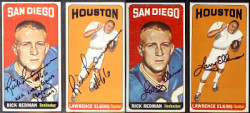 Being a collector and historian of the American Football League, I occasionally run across interesting sidebars and tidbits to the players, the league and the vast world of collectibles. One such case is the situation involving a couple of former AFL’ers and their 1965 Topps football cards. Rick Redman and Larry Elkins both began their careers in professional football in 1965. Redman, a linebacker from the University of Washington, played nine seasons for the San Diego Chargers, from 1965-1973. Elkins, a first-round draft choice of the Houston Oilers, was a wide receiver from Baylor University, whose playing time in the AFL was from 1965-1967. Both were highly-touted players coming out of college and as such, both had their first football cards appear in the famed 1965 Topps set.
Being a collector and historian of the American Football League, I occasionally run across interesting sidebars and tidbits to the players, the league and the vast world of collectibles. One such case is the situation involving a couple of former AFL’ers and their 1965 Topps football cards. Rick Redman and Larry Elkins both began their careers in professional football in 1965. Redman, a linebacker from the University of Washington, played nine seasons for the San Diego Chargers, from 1965-1973. Elkins, a first-round draft choice of the Houston Oilers, was a wide receiver from Baylor University, whose playing time in the AFL was from 1965-1967. Both were highly-touted players coming out of college and as such, both had their first football cards appear in the famed 1965 Topps set.
As we were wrapping up a telephone interview for my book, Charging Through the AFL, I asked Rick Redman if he would sign a few of his football cards if I sent them to him in the mail. He graciously agreed to sign, and added the following commentary about his 1965 Topps card:
“I am absolutely amazed at how many cards I get in the mail. I get probably three a week. I just can’t believe it. There’s a funny story about one of those cards. I don’t know if you remember a guy that was drafted the same time I was, by the Houston Oilers. He was a guy from Baylor and his name was Larry Elkins. He was an All-American at Baylor. In fact, we played against each other and were on several all-American teams at the same time. Well, Topps screwed up on the bubble gum cards and got our pictures mixed up on the cards. So every once in a while I’ll get a card that has his picture on it. And I’ll send it back and let the people know that they have something that they should really hang onto… You ought to try and find his card with my picture on it. I’ll sign that for you too. Every time we saw each other before a game we’d say, “You never looked so good as when you were on my card.” We always had this friendly banter back and forth.”
So I sent Rick Redman his 1965 Topps card to sign for me. He returned it quickly with the following note:
A few weeks later I was able to track down a 1965 Topps Larry Elkins card. I sent it to Redman to sign as well, thinking that it had Redman’s photo on it. Redman sent back the following note:
A month or so later, I purchased additional copies of the Redman and Elkins cards, this time to send to Elkins. I dropped them into the mail, headed to an address in Brownwood, Texas. A week or two went by before I got a phone call from a nice lady saying that she was Larry Elkins’ sister. She said that Larry worked overseas, but got back to the States a couple of times each year. She didn’t know how long it would take, but wanted me to know that I would get my cards back at some point. I thanked her and eventually forgot about the whole thing. But sure enough, roughly 23 months later, I received both cards back in the mail, signed by Larry Elkins. It turns out that Elkins’ sister had sent my package to him in England, and then he sent it back from there. He included the following note with his reply:
Enclosed were the Elkins and Redman cards, both signed by Larry Elkins. And so the mini-collection was complete.
Larry Elkins and Rick Redman both enjoyed prosperous careers after football. Redman returned to the state of Washington and embarked upon a long career with Sellen Construction, of which he is now the Chief Executive Officer. After a knee injury ended his football career prematurely, Elkins traveled the world working for various companies and in the entertainment industry. Prior to his retirement, Elkins spent a dozen years in Saudi Arabia, working as a consultant to the Ministry of Water, which operated 26 desalination plants, pipelines and pump stations along the Red Sea and Persian Gulf.
At the time of this writing, I am missing just 22 cards to complete my collection. Two of these men are still living; George Fleming, who appears on a 1962 Fleer card, and Don Allen, who is featured on a 1960 Fleer. With luck I will eventually be able to get those two cards signed. As for the 20 other cards of players who are all deceased? I’ll probably be hunting them for years. But I’m good with that.
Thank you for reading,
Todd Tobias

